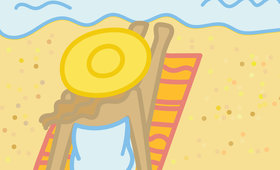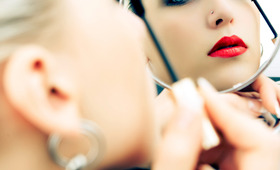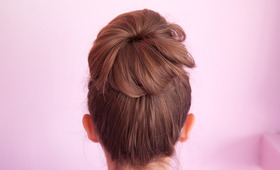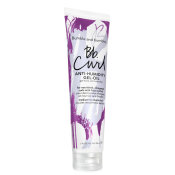
The Curly Girl Method (CGM) is a set of guidelines designed to bring out the best in naturally curly, wavy, and coily hair. CGM devotees around the world report healthier, shinier, more well-defined curls and less frizz and damage. But when you’re new to CGM, the world of curly hair care can be daunting—if not completely overwhelming. Before you throw in the towel, check out our beginner’s guide to the Curly Girl Method. It’s CGM made easy.
How to follow the Curly Girl Method
The Curly Girl Method isn’t all that different from your regular hair routine—you’ll still cleanse, condition, and style your hair. However, there are a few things you should avoid while doing CGM:
-
Sulfates
-
Non-water-soluble silicones
-
Drying alcohols
-
Heat styling
-
Brushing
CGM is all about babying your curls. Because curly hair tends to be more sensitive to dryness, damage and frizz, avoiding ingredients and styling techniques that dry out your hair is crucial. Sulfates (like sodium laureth sulfate) and drying alcohols (like isopropyl alcohol) are too harsh for curly hair and can strip your strands of moisture. Silicones that aren’t water-soluble (like dimethicone) are thought to build up on the hair shaft, making it harder for your hair to absorb the moisture it needs. Heat styling and brushing are also no-no’s except in certain situations—but more on that later.
How do I get started with the Curly Girl Method?
First, make sure you’re stocked up with CG-approved products (free of sulfates, non-soluble silicones and drying alcohols). Then, the first step for CGM is to do a “final wash” or “reset wash.” This is where you wash your hair with a clarifying shampoo (with sulfates!) to cleanse your hair of any product buildup before you get started on your curly journey.
Editor’s picks:
What should my routine look like on CGM?
Now that you’ve done your reset wash, you can kick off your regular CGM routine.
Cleanse. While doing CGM, cleanse your hair with a sulfate-free shampoo or co-wash. Some people like to give up shampoo completely and use a co-wash (we’ll explain what that is later) or cleansing conditioner, but it’s not required. While cleansing, massage your scalp with your fingertips to stimulate your skin and encourage buildup and oil to rinse away.
Editor’s picks:
Condition. Use a rinse-out conditioner after you cleanse. The best conditioner for you will depend on your hair’s individual needs, but remember that it should be free of non-soluble silicones. Many curlies apply a leave-in conditioner after their shower, too.
Editor’s picks:
- Briogeo Curl Charisma Rice Amino + Shea Curl Defining Conditioner
- Rene Furterer Sublime Curl Curl Activating Conditioner
Dry and style. Dry your hair with a microfiber towel or a cotton T-shirt using gentle blotting motions. (Regular towels can rough up the hair cuticle, causing frizz.) Apply CG-approved styling products (like gels, mousses, butters, and oils) and style your hair. Air-drying is best for the health of your hair, but blow-drying with a diffuser attachment on low heat works, too.
Editor’s picks:
- T3 Luxe Turban Towel
- Oribe Styling Butter Curl Enhancing Crème
- Briogeo Curl Charisma Chia + Flax Seed Coil Custard
- Bumble and bumble. Curl Anti-Humidity Gel-Oil
It can take a few weeks or more to start seeing results from CGM, so don’t get discouraged if your curls don’t look different right off the bat. Depending on how damaged your hair is, it can take some time for curls to recover.
Can I use shampoo on CGM?
Yes, you can! While some like to go “no-poo” (shampoo-free), it’s not required. Just make sure your shampoo is free of sulfates. Sulfates can dry out your hair, causing frizz, puffiness, breakage and damage. Instead, use gentle cleansing agents (like cocamidopropyl betaine and decyl polyglucose).
Editor’s picks:
- Briogeo Curl Charisma Rice Amino + Avocado Hydrating Shampoo
- Briogeo Farewell Frizz Smoothing Shampoo
Can I brush my hair on CGM?
Brushing is usually discouraged in CGM because it can contribute to frizz and puffiness—especially on dry hair. However, many curlies use a wide-toothed comb or Denman brush to gently detangle their hair while it’s wet in the shower. Always use conditioner or a detangling product when combing wet hair so that your comb glides through.
Can I use heat on CGM?
Heat styling is also discouraged, but diffusing your hair on a low heat setting is fine.
How often do I cleanse my hair?
For the health of your hair, it’s best to cleanse as infrequently as possible. That said, there are no hard and fast rules. If your scalp is naturally oily, you may find that you need to cleanse every few days. Those with dry scalps and hair may find that they can go longer in between wash days.
Which products should I use?
That depends on your hair! Finding the right products for you takes trial and error, but pay close attention to your hair type and porosity. If your hair is fine and gets weighed down easily, it’s best to stick to lightweight products like mousses, foams, and gels. If your hair is dry and coarse, heavier products like butters and creams can give you the definition you want.
How do I know if a product is CG-approved?
If it’s free of sulfates, non-soluble silicones and drying alcohols, it’s okay for CGM. You can use a tool like Curlsbot to check if a specific product is CG-approved or not.
How closely do I need to follow CGM?
Think of CGM as a set of guidelines, not strict rules. Everyone’s hair is different, and you may need to make some tweaks to get the best results. For example, some people with fine, wavy hair find that using a shampoo with sulfates once a month helps control product buildup. Normally, that would be a no-go in CGM, but if it works for your hair, we say go ahead!
The CGM Glossary
One of the things about CGM that can be most difficult for newbies is the lingo. CGM is full of terms that may leave you scratching your head. Ahead, we compiled a glossary of CGM terms that you can reference as you begin your curly journey.
-
Clump: sections of curls that stick (or clump) together.
-
Co-wash: a cleansing conditioner used to wash your hair like shampoo.
-
Curl pattern/type: the shape of your hair strands, which can range from loose waves to tight coils.
-
Denman brush: a brush with rows of removable bristles often used to style curly hair
-
Detangler: a leave-in product that helps loosen tangles and lubricates strands so that your fingers or a comb can glide through hair without pulling or breaking.
-
Density: the amount of hair you have on your head, or how close the hair follicles are to each other on your scalp.
-
Elasticity: how much hair will stretch when pulled without breaking. Healthy hair can stretch up to 50% of its original length and return to its normal shape without breaking.
-
Fairy knots: knots formed by a single strand of hair that has looped around itself.
-
Finger comb: using your fingers to comb through curls and detangle hair.
-
Glazing: a method of applying product by gently gliding it over hair with your hands.
-
Leave-in: a conditioner that you leave in your hair, usually applied to wet hair after cleansing and conditioning.
-
Low-poo: a low-lathering hair cleanser or shampoo.
-
Micro-plopping: a method of drying hair by using a microfiber towel or a t-shirt to gently blot your curls, gently pushing hair up towards the scalp to encourage curl formation.
-
Natural hair: curly hair that isn’t chemically relaxed or straightened.
-
No-poo: a non-lathering hair cleanser, usually cream-based.
-
Pineappling: a method of protecting your curls while you sleep by putting them in a loose ponytail on the crown of your head with a scrunchy or scarf.
-
Plopping: an air-drying technique where you pile (or “plop”) your wet curls on top of your head and wrap them them in a t-shirt or a microfiber towel.
-
Porosity: the ability of your hair to absorb and retain moisture. Porosity refers to how porous or absorbent the hair shaft tends to be.
-
Praying hands: a method of applying styling products where you smooth the product along the length of your hair with your palms pressed together.
-
Pre-poo: a moisturizing oil or treatment that hydrates hair before cleansing.
-
Protective style: a hairstyle where your ends are tucked away, protecting your curls from damage. Popular examples include braids, twists, and buns.
-
Rake and shake: a styling method that involves “raking” product through hair with your fingers and shaking curls to encourage curl formation.
-
Rinse-out: a conditioner that you apply in the shower and rinse out.
-
Roping: a method of applying product to wet hair by squeezing curls like a rope and moving hands from roots to tips.
-
Scrunching: a method of applying product by cupping your hands underneath your curls and squeezing with your fingers, moving your hand up to your head to encourage curls to form.
-
Scrunch out the crunch (SOTC): gently scrunching dried curls to remove the stiff, crunchy “cast” that hair gel forms.
-
Shrinkage: the decrease in length when your hair dries. For most curlies, wet hair appears longer than dry hair because it’s weighed down with water.
-
Slip: how lubricious (or slippery) a product makes wet hair feel after applying. If a product has a lot of “slip,” you’ll be able to glide your fingers through your hair easily.
-
Squish to condish (S2C): a method of conditioning where you mix conditioner with water and “squish” your curls with your hands to improve moisture retention.
-
Wash and go: a method of cleansing and styling your hair with minimal products and manipulation (so that you can just “wash and go”).
Featured Products
You Might Also Like
-

Wellness
Beauty and the Beach: Find Your Best Summer Skin by the Water
-

Trends
Dolphin Skin Is Here to Stay—Here’s How You Can Get the Look
-

Well-being
Mandatory Pre-Date Prep
- 875
-

Face Skincare
Got Dry Skin? Try Skin Flooding
-

How-to
Do These 10 Things to Feel Like You’re on Vacation at Home
-

Tutorials
How To Do a Sock Bun
- 8624
























